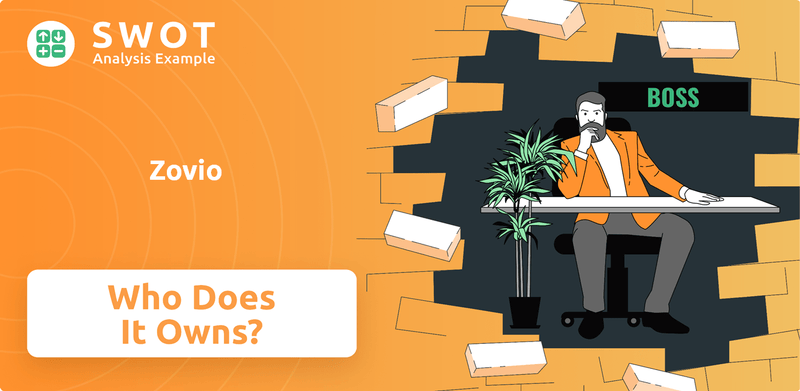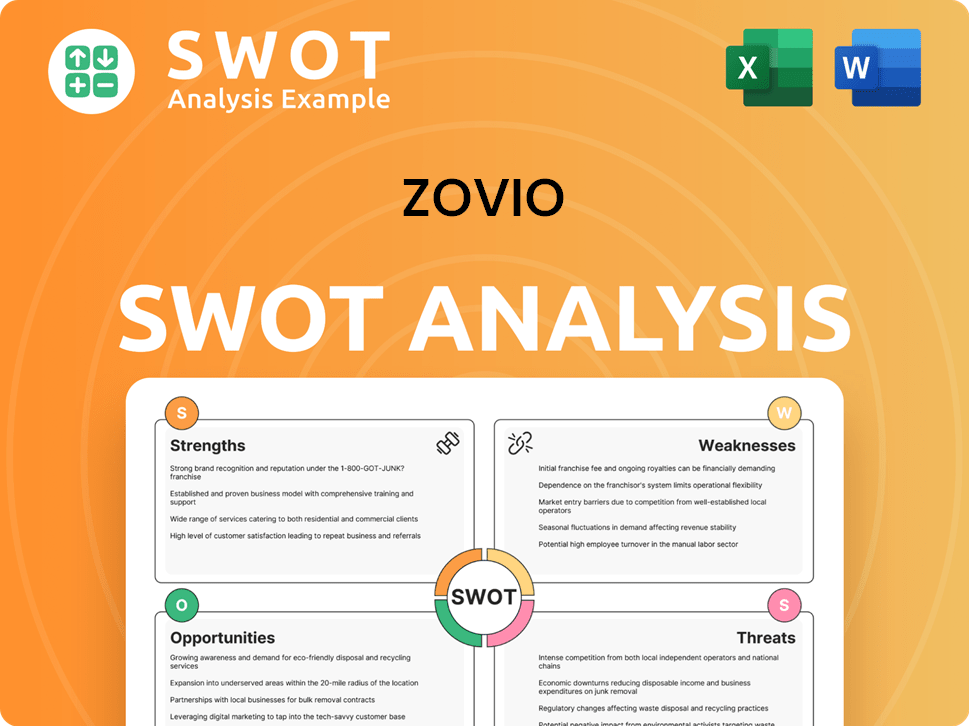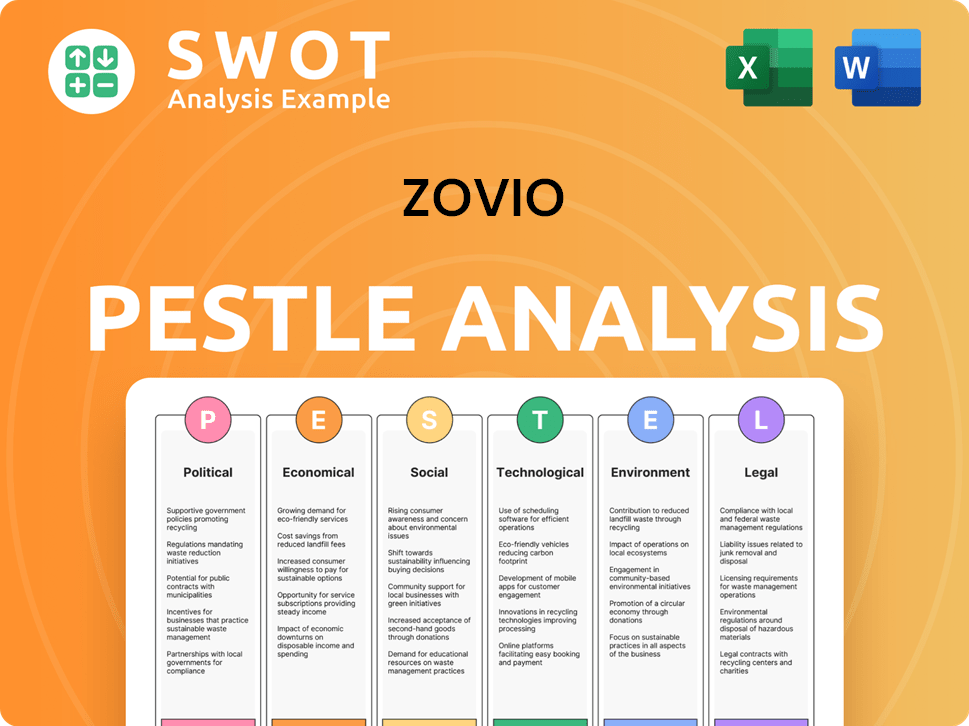Zovio Bundle
Who Ultimately Controlled Zovio?
Understanding a company's ownership is crucial for grasping its trajectory. Zovio, once a prominent player in the education technology sector, underwent significant transformations. This analysis explores the Zovio SWOT Analysis, the evolution of its ownership, and the strategic decisions that shaped its destiny.

From its origins as TeleUniversity, Inc. to its eventual dissolution, the story of Zovio's ownership reveals a complex interplay of market forces, regulatory pressures, and strategic pivots. Unraveling the Zovio company ownership structure unveils the key players and decisions that influenced its path. This exploration provides insights into the Zovio owner, its leadership team, and the ultimate factors that led to its current status, offering a valuable case study for investors and business strategists alike. Knowing who owns Zovio Inc. is crucial.
Who Founded Zovio?
The journey of Zovio, initially known as TeleUniversity, Inc., began in May 1999. The company was incorporated in Delaware, with Andrew Clark at the helm as CEO and President from its inception. This early phase was marked by the involvement of Warburg Pincus, a private equity firm, which provided crucial initial backing.
In February 2004, the company rebranded itself as Bridgepoint Education, Inc. This strategic shift set the stage for significant developments, particularly in the realm of online education. The acquisition of The Franciscan University of the Prairies in 2005, later renamed Ashford University, proved to be a transformative move.
The early ownership structure of Zovio, then Bridgepoint Education, involved key figures like Andrew Clark, the CEO, and the private equity firm Warburg Pincus. While specific equity splits are not publicly detailed, the involvement of a private equity firm suggests a structured initial ownership with a clear path for investment and potential exit. This structure is typical for companies aiming for rapid growth and expansion.
Zovio was initially incorporated as TeleUniversity, Inc. in May 1999 in Delaware.
Andrew Clark served as the CEO and President from the company's inception.
Warburg Pincus, a private equity firm, was an early investor in the company.
The company changed its name to Bridgepoint Education, Inc. in February 2004.
The acquisition of The Franciscan University of the Prairies (later Ashford University) in 2005 was a key event.
As of March 2021, Andrew Clark's beneficial ownership was 5.8% of outstanding shares.
Understanding the early ownership of Zovio, including key figures and investors, provides insight into its strategic direction and growth trajectory. The involvement of private equity firms like Warburg Pincus often indicates a focus on rapid expansion and a defined exit strategy. The acquisition of Ashford University was a pivotal move in the company's history, significantly impacting its growth. For more details on Zovio's strategic moves, consider reading about the Growth Strategy of Zovio.
- The initial incorporation and leadership structure set the foundation for Zovio's operations.
- Early investment from Warburg Pincus played a crucial role in the company's early development.
- The acquisition of Ashford University was a major turning point, driving significant growth.
- Andrew Clark, as a co-founder and CEO, held a notable stake in the company.
Zovio SWOT Analysis
- Complete SWOT Breakdown
- Fully Customizable
- Editable in Excel & Word
- Professional Formatting
- Investor-Ready Format

How Has Zovio’s Ownership Changed Over Time?
The evolution of Zovio's company ownership reflects its strategic shifts. Initially, as Bridgepoint Education, Inc., the company was publicly traded on NASDAQ under the ticker symbol ZVO. The ownership structure comprised institutional investors, mutual funds, and individual insiders. A significant transformation occurred in April 2019 when the company rebranded to Zovio and moved its stock listing to NASDAQ.
A major turning point was the August 2020 announcement of the sale of Ashford University to the University of Arizona. This sale, finalized in December 2020, changed Zovio's focus to education technology services. This transition involved providing online program management (OPM) services to the newly formed University of Arizona Global Campus (UAGC) under a long-term contract. This strategic pivot significantly impacted the company's assets and future trajectory.
| Event | Date | Impact on Ownership |
|---|---|---|
| Rebranding to Zovio | April 2019 | Stock listing on NASDAQ |
| Sale of Ashford University | August 2020 (announced), December 2020 (completed) | Shift to education technology services; altered asset base |
| Liquidation | 2024 | Company closed its operations |
As of May 2025, Zovio Inc (US:ZVO) had very limited institutional ownership. Truepoint, Inc. and Huntington National Bank were the only institutional owners, holding a combined total of only 48,485 shares. This represents approximately 0.142% institutional ownership, with the remaining 99.9% held by the general public. This low institutional ownership and high retail ownership likely reflect the company's challenging financial position and eventual liquidation.
Zovio's ownership structure evolved significantly, marked by strategic shifts and asset sales.
- The company transitioned from owning for-profit colleges to providing education technology services.
- Institutional ownership was minimal by May 2025, with most shares held by the general public.
- Key events included rebranding and the sale of Ashford University.
- The company's financial challenges led to its liquidation.
Zovio PESTLE Analysis
- Covers All 6 PESTLE Categories
- No Research Needed – Save Hours of Work
- Built by Experts, Trusted by Consultants
- Instant Download, Ready to Use
- 100% Editable, Fully Customizable

Who Sits on Zovio’s Board?
The Board of Directors of Zovio, played a pivotal role in guiding the company's strategic direction, especially during its transition and eventual dissolution. While a comprehensive list of board members at the time of the company's operational cessation isn't readily accessible, the board oversaw key leadership changes and strategic decisions. In 2021, after co-founder and CEO Andrew Clark's departure, John Silvanus Wilson, Jr., and Ron Huberman joined the board. Randy Hendricks was appointed as the new CEO in December 2021. This leadership shift highlights the board's influence on the company's trajectory.
The board's responsibilities became particularly critical during the company's financial difficulties and legal issues, such as the $22.4 million fine from the California Attorney General's case against Ashford University. The board's decision to liquidate assets and dissolve the company in late 2022 underscores their ultimate authority in determining the company's future. Understanding the board's actions provides insight into the factors that led to the company's closure. The board's decisions were crucial in navigating the challenges faced by Zovio.
| Role | Name | Notes |
|---|---|---|
| Former CEO | Andrew Clark | Co-founder, left in 2021 |
| Former Board Member | John Silvanus Wilson, Jr. | Former Morehouse College President |
| Former Board Member | Ron Huberman | Former superintendent of Chicago's public schools |
| Former CEO | Randy Hendricks | Appointed December 2021 |
The voting structure for publicly traded companies like Zovio typically follows a one-share-one-vote system. Each share of common stock grants one vote on shareholder matters, including director elections. Shareholders generally vote for the board at annual meetings, either in person or by proxy. The election of directors usually occurs by a plurality vote. Major shareholders, including institutional investors, would have likely exerted influence through their voting power. Considering the company's history and the decisions made by the board, understanding the ownership structure and the influence of major shareholders is crucial. To learn more about the company's strategy, you can read about the Target Market of Zovio.
The Board of Directors at Zovio oversaw critical strategic shifts and leadership changes, including the appointment of new board members and a new CEO.
- The board's decisions were crucial during the company's financial distress and legal challenges, ultimately leading to the company's dissolution in late 2022.
- Voting typically followed a one-share-one-vote system, with major shareholders likely influencing outcomes.
- Understanding the board's role and the voting structure is essential for grasping the company's trajectory.
- The board's actions highlight their ultimate authority in shaping the company's fate.
Zovio Business Model Canvas
- Complete 9-Block Business Model Canvas
- Effortlessly Communicate Your Business Strategy
- Investor-Ready BMC Format
- 100% Editable and Customizable
- Clear and Structured Layout

What Recent Changes Have Shaped Zovio’s Ownership Landscape?
The past few years have seen significant shifts in the Zovio owner landscape, culminating in the company's complete cessation of operations. After selling Ashford University in 2020, Zovio Inc focused on educational technology services, including TutorMe and Fullstack Academy. However, the company faced considerable financial challenges, reporting a $61 million annual loss for 2020 and further losses in 2021. These developments significantly impacted the Zovio company ownership structure.
In May 2022, Zovio sold TutorMe for $55 million to GoGuardian, a move to address financial liabilities, including a $22.4 million fine from a California lawsuit. In July 2022, the University of Arizona Global Campus (UAGC) acquired Zovio's online program management (OPM) business for $1 in cash, assuming $20 million in rent obligations and agreeing to pay Zovio 15% of tuition net revenues. By November 2022, Zovio liquidated its final asset, Fullstack Academy, selling it to Simplilearn. These actions were part of a plan approved by shareholders in October 2022 to liquidate assets and dissolve the company. The company officially closed its business on September 11, 2022. You can read more about the company's business model in this article: Revenue Streams & Business Model of Zovio.
| Event | Date | Details |
|---|---|---|
| Sale of Ashford University | 2020 | Focused on educational technology services |
| Sale of TutorMe | May 2022 | Sold for $55 million to GoGuardian |
| Acquisition of OPM business | July 2022 | UAGC acquired for $1 cash and other considerations |
| Sale of Fullstack Academy | November 2022 | Sold to Simplilearn |
| Company Dissolution | September 11, 2022 | Zovio officially closed its business |
The series of events reflects a broader industry trend of consolidation within the education technology sector. The Zovio stock is no longer traded, as the company has ceased operations. The Zovio company history demonstrates a strategic re-evaluation in the for-profit higher education sector. The Zovio's current status is dissolved, with all assets liquidated and operations terminated. The Zovio ownership structure has been completely dissolved.
Zovio reported an annual loss of $61 million in 2020, highlighting the financial difficulties faced by the company.
The sales of TutorMe, OPM business, and Fullstack Academy were part of a strategic liquidation plan.
Shareholders were warned that little to no payout might be available due to the company's liabilities.
The events reflect a broader trend of consolidation and strategic re-evaluation within the education technology sector.
Zovio Porter's Five Forces Analysis
- Covers All 5 Competitive Forces in Detail
- Structured for Consultants, Students, and Founders
- 100% Editable in Microsoft Word & Excel
- Instant Digital Download – Use Immediately
- Compatible with Mac & PC – Fully Unlocked

Related Blogs
- What are Mission Vision & Core Values of Zovio Company?
- What is Competitive Landscape of Zovio Company?
- What is Growth Strategy and Future Prospects of Zovio Company?
- How Does Zovio Company Work?
- What is Sales and Marketing Strategy of Zovio Company?
- What is Brief History of Zovio Company?
- What is Customer Demographics and Target Market of Zovio Company?
Disclaimer
All information, articles, and product details provided on this website are for general informational and educational purposes only. We do not claim any ownership over, nor do we intend to infringe upon, any trademarks, copyrights, logos, brand names, or other intellectual property mentioned or depicted on this site. Such intellectual property remains the property of its respective owners, and any references here are made solely for identification or informational purposes, without implying any affiliation, endorsement, or partnership.
We make no representations or warranties, express or implied, regarding the accuracy, completeness, or suitability of any content or products presented. Nothing on this website should be construed as legal, tax, investment, financial, medical, or other professional advice. In addition, no part of this site—including articles or product references—constitutes a solicitation, recommendation, endorsement, advertisement, or offer to buy or sell any securities, franchises, or other financial instruments, particularly in jurisdictions where such activity would be unlawful.
All content is of a general nature and may not address the specific circumstances of any individual or entity. It is not a substitute for professional advice or services. Any actions you take based on the information provided here are strictly at your own risk. You accept full responsibility for any decisions or outcomes arising from your use of this website and agree to release us from any liability in connection with your use of, or reliance upon, the content or products found herein.